Yesterday’s live coverage of the Ukraine conflict can be found here. An archive of our liveblogs can be found here. For an overview and analysis of this developing story see our latest podcast.
Please help The Interpreter to continue providing this valuable information service by making a donation towards our costs.
View Ukraine: April, 2014 in a larger map
For links to individual updates click on the timestamps.
For the latest summary of evidence surrounding the shooting down of flight MH17 see our separate article: Evidence Review: Who Shot Down MH17?
The air space over Dnepropetrovsk is closed until December 15 due to threat of a terrorist attack, Ukrainska Pravda reported, citing a source in the airport administration (translation by The Interpreter):
A NOTAM [Notice to Airmen] came into the Dnepropetrovsk airport (information or notice disseminated urgently on changes in the rules for handling and securing plights and in air navigation information) in which the closure to flights for 2 days, until December 15, was indicated.
The NOTAM said that the Dnepropetrovsk air space was closed “due to security concerns,” implying it was the threat of a terrorist attack, said Ukrainska Pravda.
Kharkov and Zaporozhye airports were also closed last night, according to a report yesterday, December 12.
But at the National Security and Defense Council (NSDC), officials said they had no information about why Gosaviasluzhba, the State Air Service, was closing the airports in the three cities. At a briefing, spokesman Andrey Lysenko said the reasons were not known, and that the decision was up to the company managing the air traffic.
Denis Antonyuk, head of the State Aviation Service, said at first it was not certain how long the airports would remain close as assurances of safety had to be obtained, but then later it was announced that the airports will reopen on Monday, December 15, Korrespondent.net reported.
TSN reported that passengers were being provided free buses to Kiev where they would catch other flights.
Airports in Odessa, Lvov and Kiev were operating normally.
— Catherine A. Fitzpatrick
The OSCE Special Monitoring Mission (SMM) has released a press release at 9:30 pm GMT, describing a halt and attack by Russian-backed fighters from the self-declared “Donetsk People’s Republic”:
SMM patrol of two vehicles was stopped and threatened by “Donetsk People’s Republic” (“DPR”) forces in Pyschevyk (23km North-East of Mariupol city, located in the security zone).
At 10:15hrs, an SMM patrol of two vehicles was stopped in Pyschevyk by 16 “DPR” members, some of whom pointed their weapons at the patrol. Two SMM members immediately exited the first vehicle and announced that they were representing the OSCE. Some “DPR” members approached the second vehicle and attempted to break its window. The “DPR” ordered the SMM staff to hold their hands up and stand next to their vehicles while they conducted a search of the two SMM vehicles. One “DPR” member struck a SMM monitor on the leg with the butt of a rifle, causing a minor soft-tissue injury.
The SMM was then instructed to “proceed” further down the road towards Oktyabr (28km North-East of Mariupol), followed by a BTR-82 armoured vehicle. The “DPR” directed the SMM approximately a kilometre away towards Oktyabr where the staff members were again asked to exit their vehicles. Following some 30 minutes of hold-up and negotiations, and as a result of the SMM patrol leader’s insistence that they speak to their commander, the “DPR” members allowed the SMM to leave under the condition that they proceed to “DPR”-controlled Pavlopil to verify shelling which had allegedly occurred earlier in the morning.
Earlier we reported that a huge military convoy with Russian tanks has been geolocated heading south toward Mariupol.
— Catherine A. Fitzpatrick
The video is posted with the following description (translated by The Interpreter):
LNR [Lugansk People’s Republic] has begun unilateral withdrawal of heavy artillery and grad launchers from the frontline.
According to the man speaking in the video, these vehicles are withdrawing from the front lines in accordance with the Minsk ceasefire agreements. These vehicles include BM-21 Grad rocket launchers (under tarps) which are not allowed to be within a 15 km buffer zone, according to the Minsk Accord.
That video appears to have been taken here on the map, since a sign for Slavyanoserbsky District is clearly visible in both.
@djp3tros has determined for The Interpreter that according to these landmarks, the vehicles are headed in the direction of the Russian border:
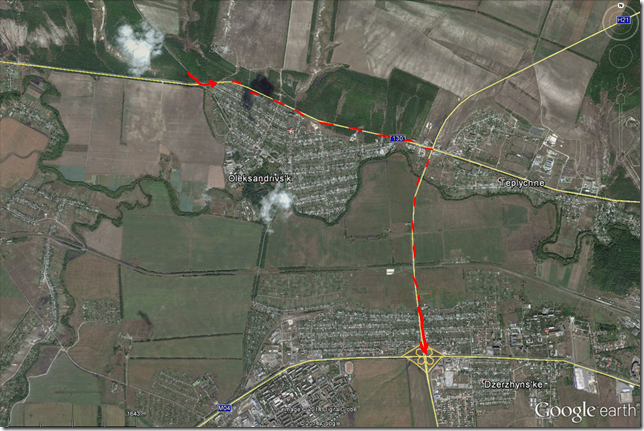
In both this video and the ones we have posted below, large columns of heavy equipment, all of which likely came from the Russian military and, as we point out below, some of which could not have come from anywhere else, appear to be withdrawing from the front lines. However, the videos in our previous update show that this armor is actually moving toward Mariupol where one of the only reported ceasefire violations today has taken place. These vehicles are near Lugansk, but as we reported earlier another ceasefire violation has occurred not far from these vehicles, near Frunze, Schastye and Donetskoye.
In other words, it may look like this movement of artillery, armor, troops and supplies is a withdrawal, but it may be a wolf in sheep’s clothing.
It’s also a remarkable parade which displays only a tiny portion of the heavy arms which the separatists have been given by their allies in Moscow.
Earlier we reported that the ceasefire appeared to be holding. Now Ukraine is less certain and new attacks are being reported. Are these videos signs that the ceasefire is being met, or is about to be shattered? We’re not sure yet.
— James Miller
Ukrainska Pravda reports that Mark Feygin, a lawyer for Nadezhda Savchenko, a Ukrainian military officer who was captured by separatist fighters, illegally rendered to Russia, and is now facing charges for murder in Moscow, has announced that his client is considering going on hunger strike if the case against her proceeds without taking into account her status as a prisoner of war.
Feygin posted two letters written by Savchenko, addressed to the Russian Investigative Committee (Sledkom) and the International Committee of the Red Cross (ICRC).


In her letters Savchenko explains that as a member of the Ukrainian Armed Forces she is a prisoner of war and therefore subject to the rights of such under the Geneva Convention.
Feygin said that, in accordance with Russia’s international obligations, the case against Savchenko must be suspended.
Feygin also tweeted that Savchenko was considering going on hunger strike if her rights, as a prisoner of war, were ignored by the Russian authorities.
US Ambassador to the OSCE, Daniel B. Baer, expressed in a statement to the OSCE in Vienna his concerns that members of the Ukrainian military reportedly fired warning shots at a convoy of the special monitoring mission (SMM):
Ukrainian military convoy fired shots in the air in the vicinity of an SMM patrol on Tuesday. While certainly much less grave than previous incidents where separatists targeted SMM patrols, or shot at UAVs, this incident underscores the vital importance of everyone ensuring the safety and security of SMM monitors.
However, Baer carefully notes that these were only warning shots, and that Russia remains the primary cause for the crisis in eastern Ukraine:
Mr. Chair, this incident does not distract our attention from the fundamental fact that Russia’s aggression in Ukraine is at the root of the crisis. As our ministers overwhelming made clear in Basel last week, it is incumbent upon Russia to stop violating its international legal obligations and contravening the fundamental principles and commitments of this Organization. Russia’s destructive actions have led to thousands of lives lost and thousands more irreparably damaged. These actions undermine our collective security. As Secretary Kerry said in Basel, the crisis we confront is not a flaw in the principles and rules of the international system—it is the failure of the Russian Federation to abide by those principles and rules.
Last week also saw a significant anniversary. On December 5, 1994, the Russian Federation, the United States, and the United Kingdom signed the Budapest Memorandum on Security Assurances. In that memorandum, the signatories confirmed their obligations to respect the territorial integrity and political independence of Ukraine, and to refrain from the threat or use of force against Ukraine. The Budapest Memorandum was one of the instruments that marked the end of the Cold War and a new period for Europe. Unfortunately, twenty years later, the Russian Federation is violating Ukraine’s sovereignty and territorial integrity, flouting the commitments of non-aggression enshrined in the Budapest Memorandum and elsewhere.
We continue to support the Minsk agreements as the basis
for a sustainable resolution of the crisis in eastern UkraineMr. Chair, we have said all along that there must be a political solution, and we continue to support the Minsk agreements as the basis for a sustainable resolution of the crisis in eastern Ukraine, and the Trilateral Contact Group as the best means for negotiation. In that vein, we welcome the news that Ambassador Tagliavini has agreed to continue in her role during the Serbian Chairmanship next year. We strongly support her work and laud her past performance, given the difficulty of the task and her unceasing efforts to advance a peaceful solution. The day of silence announced by President Poroshenko for December 9 offered yet another opportunity to kick start implementation of Minsk. We urge Russia and its proxies to end hostilities, and we thank Ambassador Tagliavini for her ongoing efforts to see that the Trilateral Contact Group of Russia, Ukraine, and the OSCE can serve as a platform to support progress on Minsk implementation.
Despite the challenges, there is a way for Russia to end its isolation. As dozens of ministers did in Basel, we once again call on Russia to implement the Minsk agreements fully, including by: supporting restoration of Ukrainian sovereignty over its side of the border, supporting OSCE monitoring of the entirety of its border with Ukraine, pressing the separatists to honor the ceasefire, releasing all hostages, and repudiating the illegal so-called “elections” held on November 2. Russia must also cease funneling fighters, military equipment and materiel, including tanks, armored vehicles, and heavy artillery, to the separatists. And Russia must end the occupation of Crimea.
The full statement can be read here.
It’s interesting that Baer brings up the Budapest Memorandum, the agreement which saw Ukraine give up its nuclear weapons in exchange for security guarantees from Russia. This has many in Ukraine second-guessing that decision, and many world leaders concerned that this conflict will incentivize the nuclear proliferation.
Video was uploaded today showing an extremely large convoy of military vehicles bearing separatist flags, marked with the legend “to Mariupol” on their sides.
The video’s description (translated by The Interpreter):
A video with a convoy of DPR armor has been uploaded to YouTube today December 12 showing a convoy apparently moving toward Mariupol. At 0:06 the name “Oplot” can be seen on the tank which is the name of the battalion founded by Aleksandr Zakharchenko and “Somali,” the battalion run by the fighter nicknamed “Givi.”
There are BMPs, tanks, and trucks hauling artillery in the convoy, and also trucks with anti-aircraft systems. Snow is visible in the first few minutes, so the video is likely new, but the road could not be verified.
While the exact date of filming is unknown, it appears to have been recorded recently given the snow.
The location of a different set of videos (video 1, video 2), however, have been worked out by @djp3tros of Ukraine At War, who geolocated the video for The Interpreter:
This places the convoy here, headed south.
Here is a map indicating the position of the convoy (marked by a red star) and two locations near Mariupol where separatist military activity was reported earlier (marked by yellow pins, see our previous report below for details):
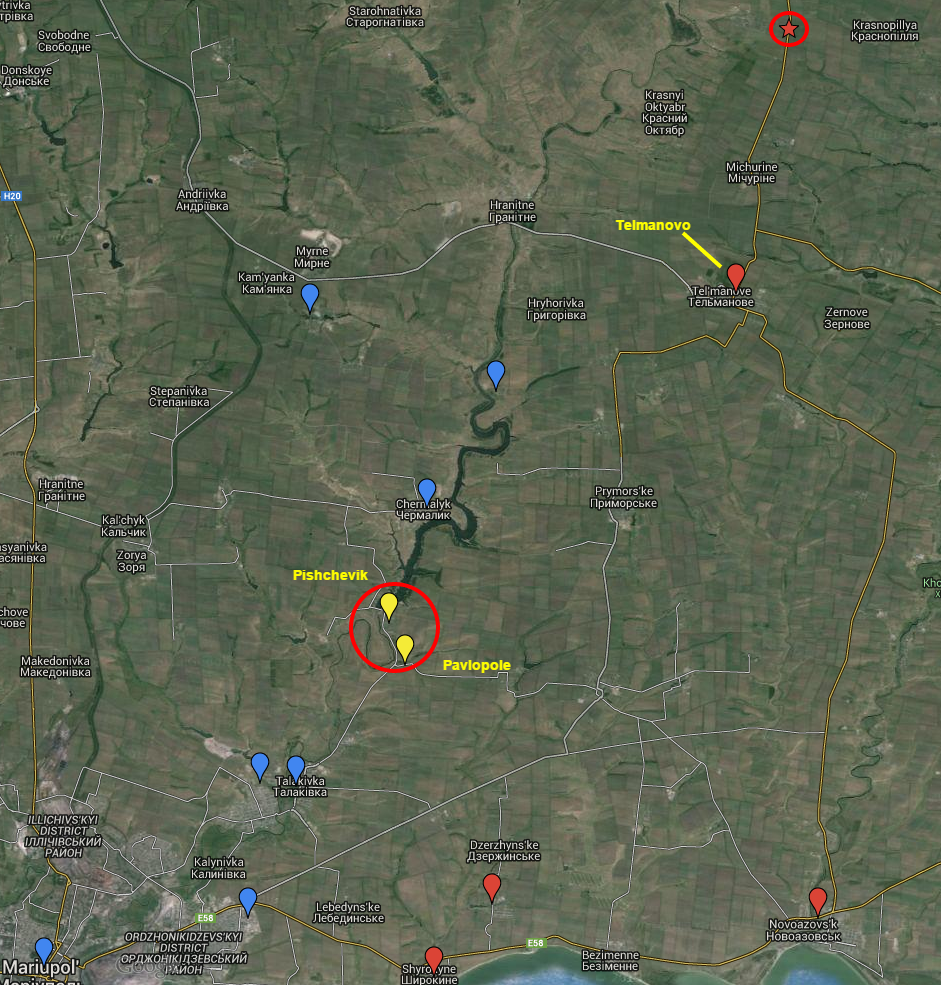
This means that the column may indeed be headed towards the front lines between Russian and Ukrainian forces as the road from Starobeshevo, through Telmanovo, to Novoazovsk, is under the complete control of Russian-backed forces.
The column in the first video, which may or may not be the same one as the column in the next set, includes a large number of tanks (both T-64BV and T-72BR), BMP-2s, BTR-80s, and military trucks, some towing artillery pieces.
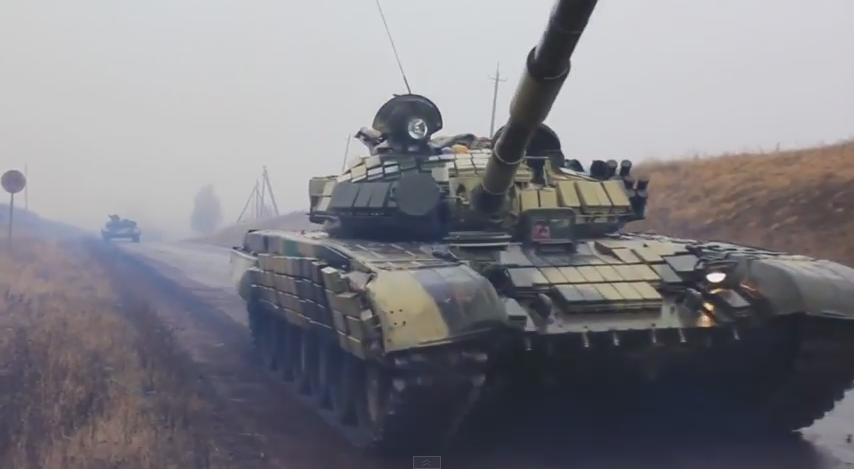
T-72BR – This tank is not in the Ukrainian military arsenal. This is strong evidence that it was supplied to the separatists from Russian military stockpiles.
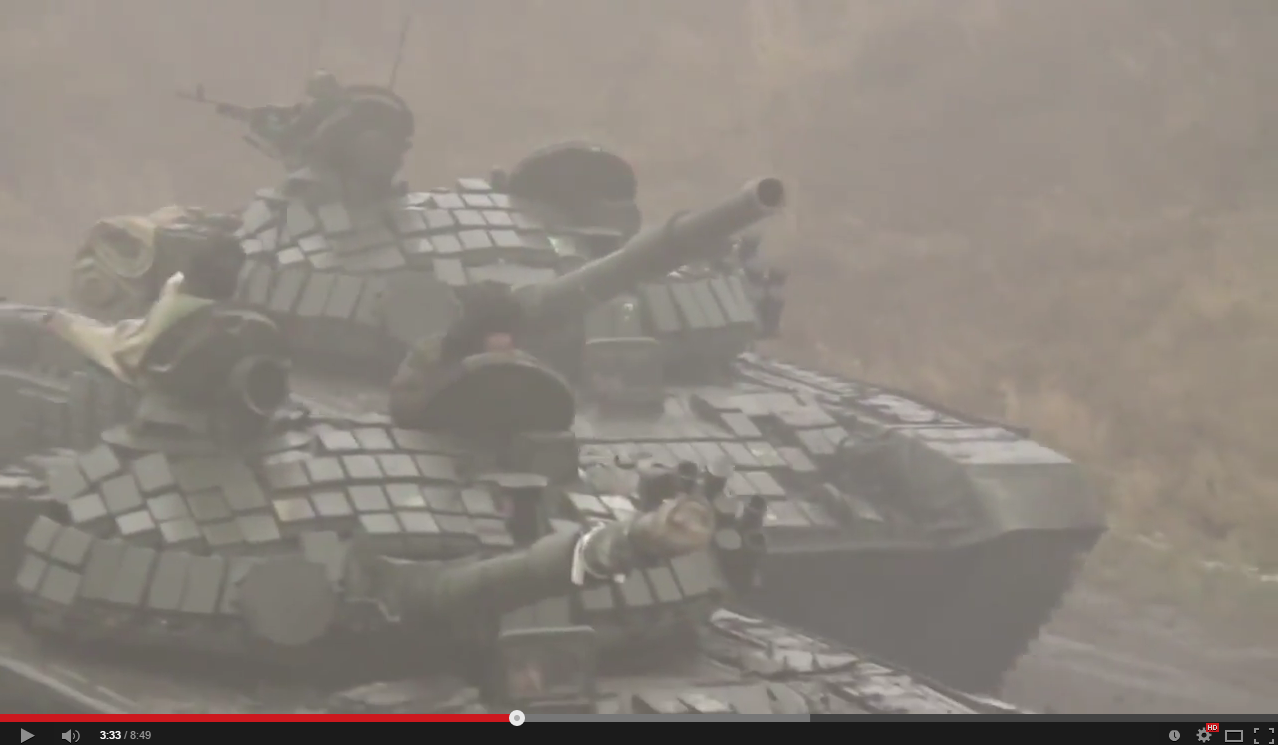
T-72BRs
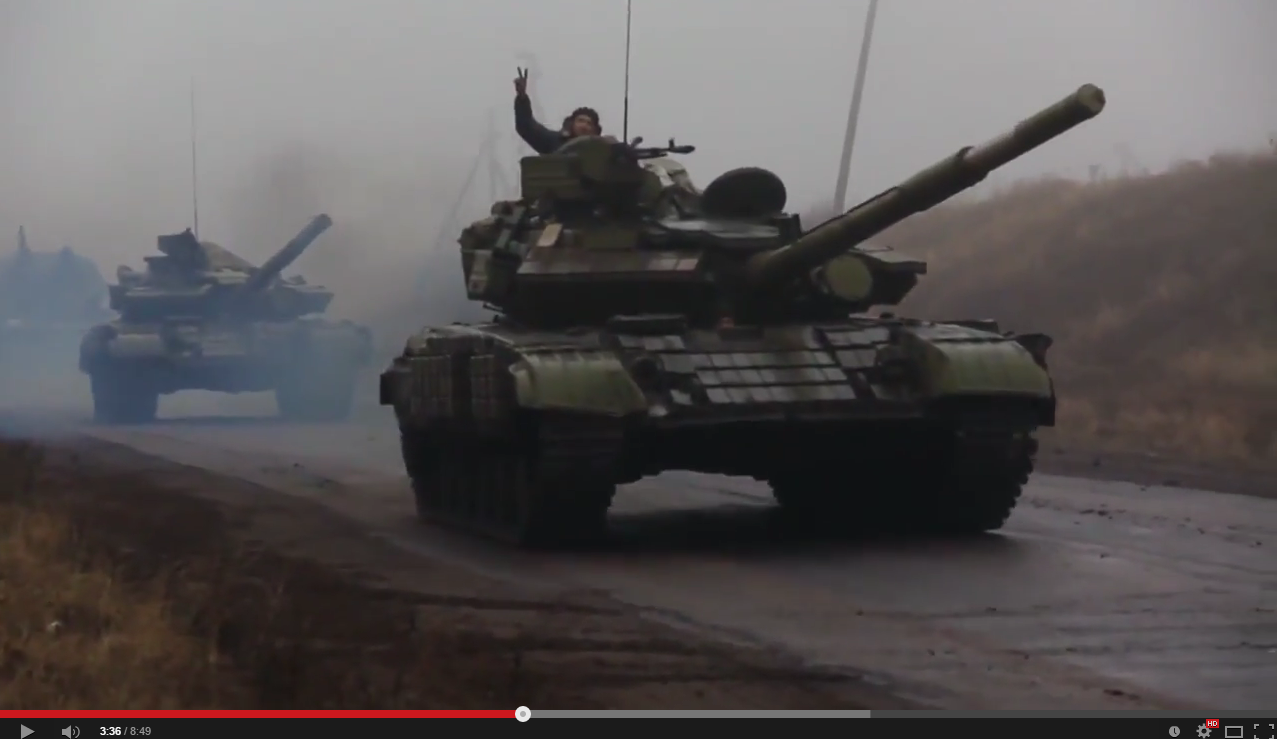
T-64BVs
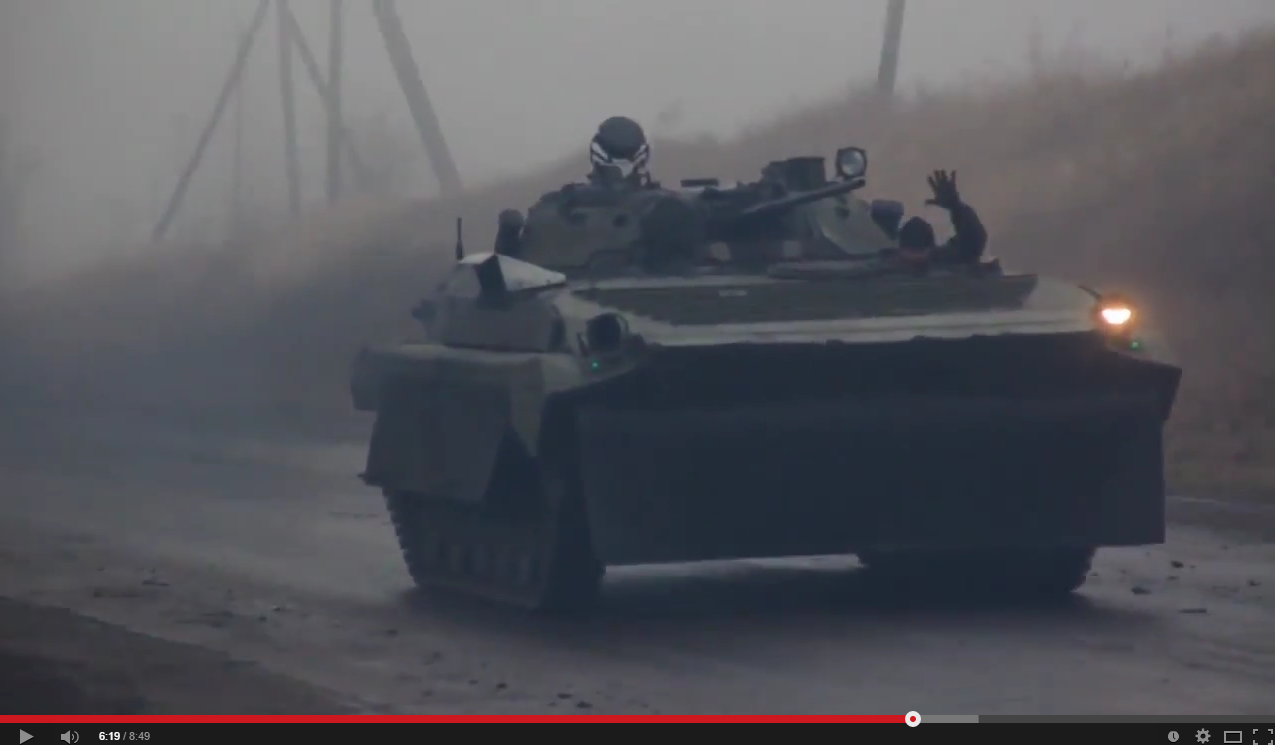
BMP-2
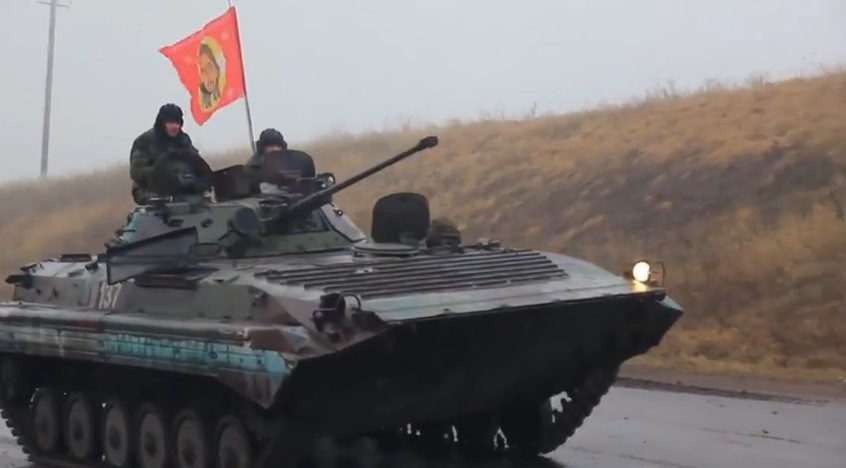
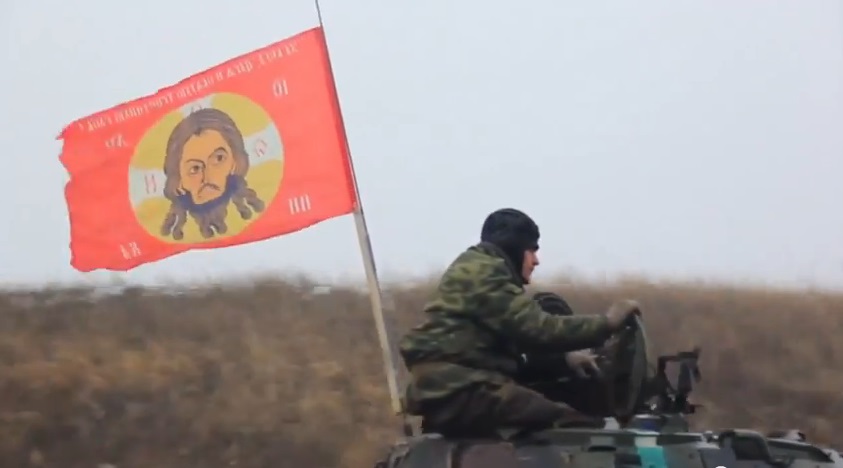
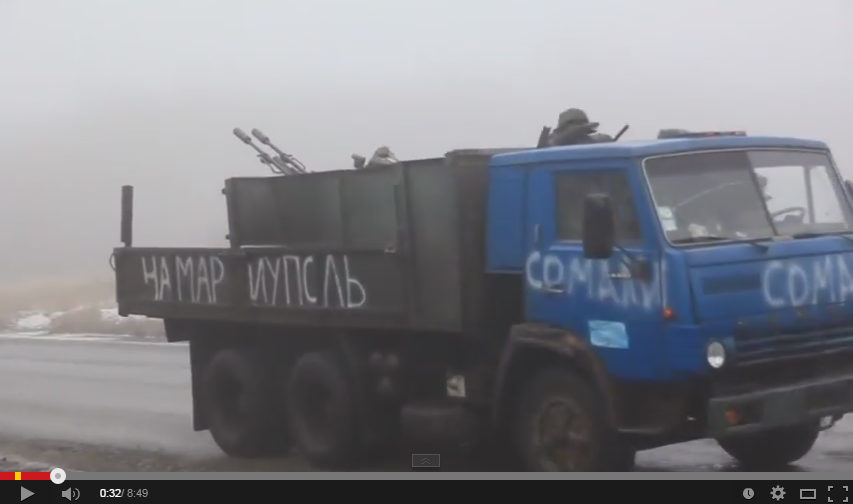
Flatbed truck with ZU-23-2 anti-aircraft gun.
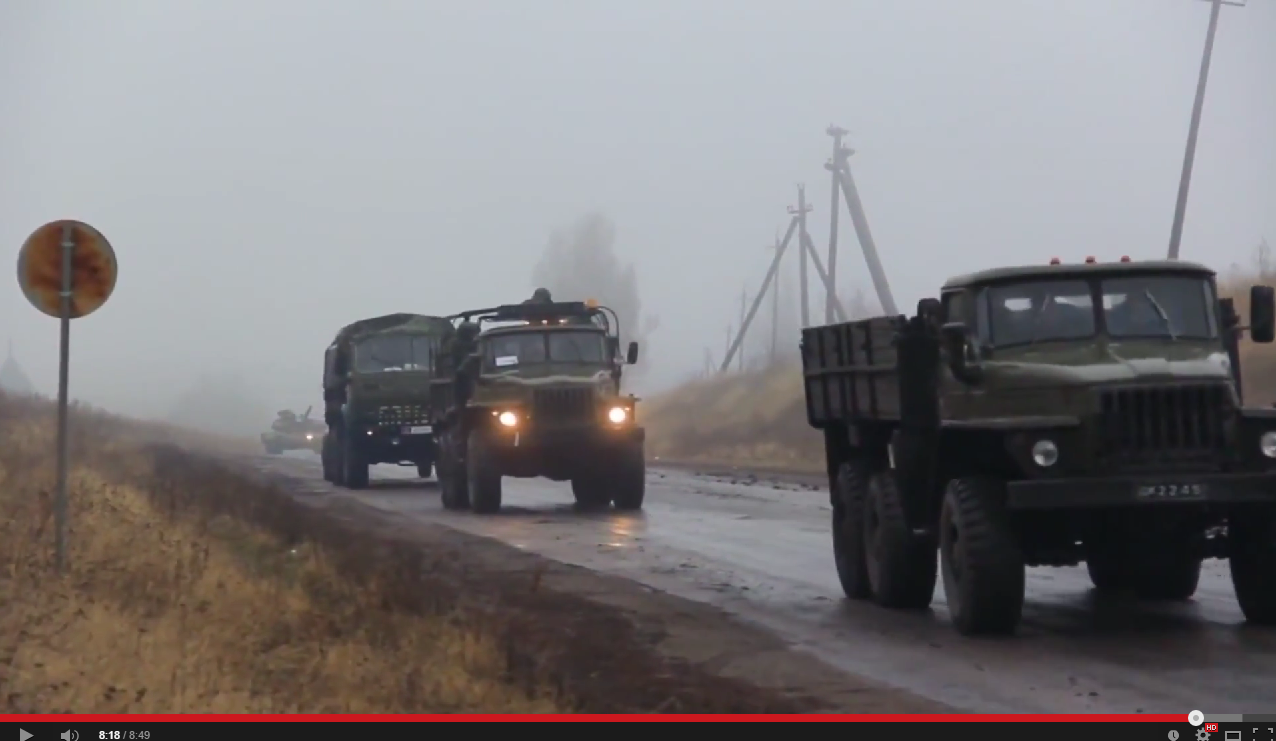
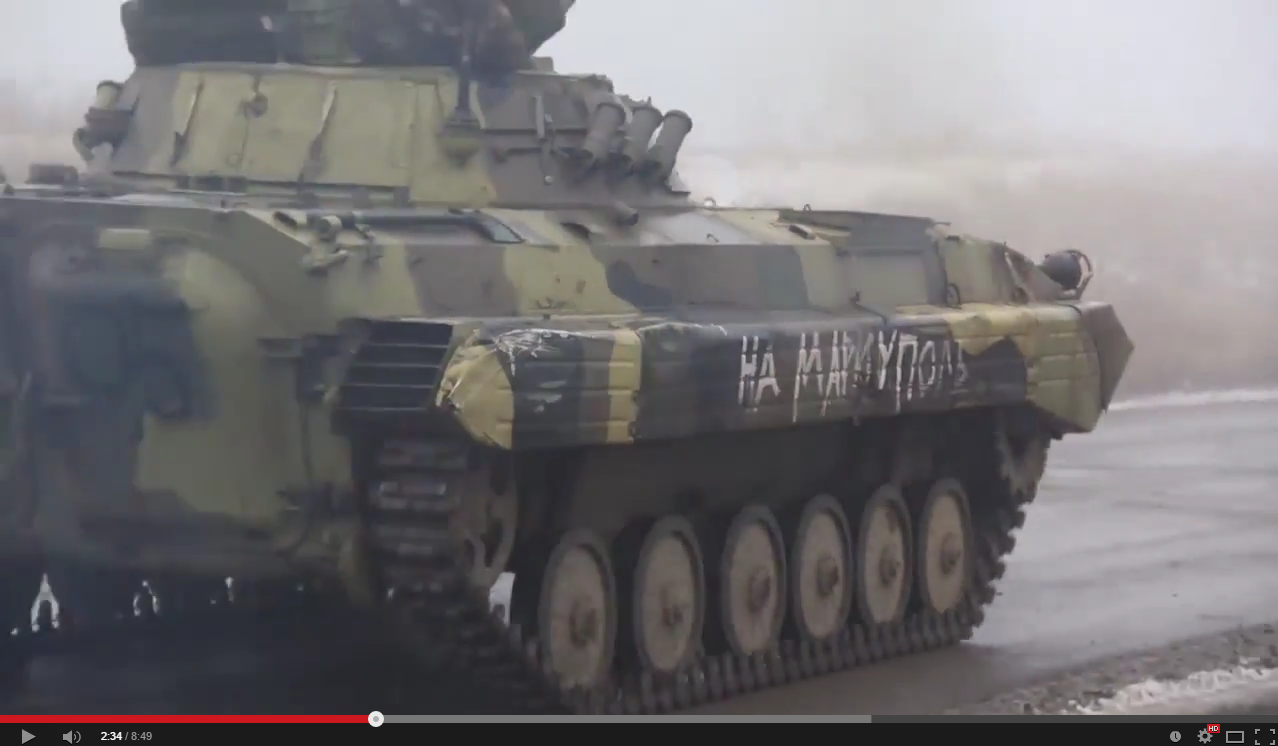
“To Mariupol”
Mariupol news site 0629.com.ua reported that Dmitry Gorbunov, the head off the press office for the Mariupol sector of the Ukrainian government’s Anti-Terrorism Operation, has announced that there are now enemy forces near Mariupol, claiming that the footage was either “fake” or recorded near Russian-occupied Novoazovsk.
This, of course, does not contradict the location established for the video: the column is not presently near Mariupol, but it is headed south on a road that leads towards the front.
It is important to note that there are multiple cameras used in making this video, some from a higher position on the roadside. This would indicate that the filming was arranged in advance. This footage was then likely released as a form of psychological warfare, to intimidate the population of Mariupol during a period of “ceasefire.”
Such measures have been seen before, in September, when numerous pro-separatist news sources claimed the capturing of villages and towns to the west of Mariupol in areas that were, from all appearances, still under government control.
That the convoy, at some time in recent days, was headed south towards the southern front, and that the Ukrainian military reported that Russian-backed forces are staging near Pishchevik, to the north-east of Mariupol, is known. Whether this column will be deployed in a fresh offensive is another matter.
— Pierre Vaux
Interfax-Ukraine reports that the ATO Press Centre has announced that five attacks have been made by Russian-backed forces today as of 13:00 local time (11:00 GMT).
A statement from the press centre reads (translated by The Interpreter):
The terrorists opened fire with anti-tank missiles, mortars and artillery near the settlements of Frunze, Schastye and Donetskoye. However they have chosen the Mariupol area as a staging ground. At first they began firing on the outskirts of the village of Pishchevik. A little later, on territory controlled by the militants near Pishchevik, loud blasts from Grads were heard.
The statement said that, at around 11:00 (9:00 GMT), separatist fighters stopped a group of OSCE observers.
The ATO Press Centre claimed that the separatists had aimed to mislead the observers and blame Ukrainian forces for shelling damage:
“They took the international observers to a school on the outskirts of Pavlopole that had been “prepared” in advance by the terrorists. And, showing them the ruined school, claimed that it had been destroyed by Ukrainian troops.”
— Pierre Vaux
Long-time watchers of this conflict may be surprised to learn that despite the fact that every attempt at a ceasefire before now has failed miserably, a ceasefire does appear to be in effect.
Two days ago the Ukrainian military reported that there were no Grad rocket attacks, but artillery attacks continued. Yesterday, Ukraine said that as of 6 PM there had only been two attacks against Donetsk airport, and both of those were with a grenade launcher — no shelling. Today the National Security and Defense Council is reporting only a handful of ceasefire breaches — and no shelling:
Russian news sources report that trucks from the ninth ‘humanitarian convoy’ to have set off to Ukraine from Russia have arrived in the separatist-held cities of Lugansk and Donetsk,
The state-owned TASS news agency reports that they were informed by the press office of the Russian Emergencies Ministry that more than 50 vehicles, carrying over 400 tonnes of aid, had arrived in Donetsk.
The other section of the column, made up of more than 80 vehicles carrying over 800 tonnes of aid, had, the ministry said, arrived in Lugansk.
TASS reported that the Lugansk-bound convoy was carrying, amongst other things, 147 tonnes of tinned meat and 130 tonnes of sugar.
The Ukrainian National Security and Defence Council has, in contrast to statements made in the TASS report linked above, denied that Ukrainian customs officials were able to inspect the convoy: